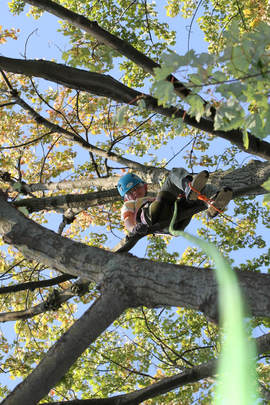 The confidence you have in yourself has a major impact on your level of happiness through life. When I am lacking in confidence as I take on a new task, I find myself immobilized by fear, uncertainty, and feelings of anxiety. My mind says things like, "I can't", "I don't know how", and "I haven't done this before". The view forward is obscured and the task appears overwhelming. Have you experienced this? Have you seen it in your children? Confidence plays an important role in everybody’s life. A person's level of self-confidence is directly related to the level of success they can achieve in pursuit of their life goals. Fortunately, as it is with most skills, we can maintain and build confidence through regular practice. Rock climbing and climbing trees are not only hobbies I enjoy, they provide opportunities for me to build confidence in my abilities. Working through the challenges I face in these hobbies can either build or diminish my level of confidence. Since tree climbing is a hobby I share with others, it provides me the additional perspective of watching others work through their own challenges. In working with many climbers through the years, I have noticed three important steps in building confidence: overcome self-doubt, split a large goal into a series of smaller goals, and focus attention inward. Overcoming Self Doubt "Whether you think you can or think you can't, you are right." Negative self-talk is the first thing that must go. As the case with most challenges, if you are to have any chance at successfully climbing to the top of the tree you will need to overcome self-doubt. This doubt tends to be triggered by fear. Each of us has our own fears to work through. Fear of heights. Fear of embarrassment. Fear of failure. Brand new experiences can be scary. For those facing and working through a fear, self-doubt creates an obstacle. Simply taking the initiative to try something new may be enough to help you overcome your fear. That first step might give you a boost in your confidence. Pair that with a little know-how and you are better able to pursue your goal for the day. My role as a facilitator is to aid you on your journey to reaching your goal. I can show you the technique yet I cannot climb the tree for you. Once you are on rope, my words are all I have to help you. More often than not, they are more than enough if I use them to convey positive thoughts and encouragement. Our fears express themselves in the words we use. This means that the words you use have a profound impact on how well you will perform. "I can't" seems to be the most common and inhibiting phrase I hear people say. These words are typically uttered within one minute of trying to climb; which leads me to believe they are spoken more out of reflex or conditioning. A coach or facilitator can help present a positive environment, but your self-talk often has the biggest impact. In order to move forward, we must stop the negative self-talk. We can replace it with positive words like, "I can do this" and "I am doing it." Speaking and thinking positive words and thoughts instills confidence. Building on a Series of Smaller Goals "What would you attempt to do if you knew you could not fail?" Sometimes our goal is so lofty that we have no idea how to achieve it or even where to begin. In order to reach the goal, we will need to break it down into smaller steps. There are many reasons why this approach leads to success, but I think a primary driver is that it allows us to realize successes at each step. With a small boost in confidence at each step, we are energized and ready to take the next step. With each successive step our confidence continues to grow. When Thomas came to climb with us his first time, his sight was set on climbing to the top of the tree. He came with confidence. As he began to ascend, his focus appeared to be strictly on reaching the top. Focused on that goal, he began to struggle because he tried to skip some of the steps involved in the climbing technique. The sit-stand technique is the foundation of the climbing method. Given his struggle, he naturally resorted to trying alternative methods like pulling with his arms and kicking his legs out. When he realized he was still not getting higher, his frustration began to build and his confidence plummeted. When trying to help a person build confidence, they must be allowed to work on their challenges. Personal growth happens through personal experiences of trial and error. Constantly telling a person how to do something or doing it for them robs them of these invaluable lessons. By having Thomas turn his attention back to the basic steps in the climbing technique, he was able to focus on the fundamentals needed to ascend. The steps necessary to reach his overall goal. With his focus back on using his legs versus his arms, he began to regain some of his confidence. After repeating the process a few times, he realized that he had ascended to 15 feet on his own. In a short period of time, his smaller goal of reaching the first branch was achieved. After a short break to acclimate himself to the height he had climbed (it feels a lot higher when you are looking back down at the ground!), he proceeded to climb higher. Eventually, his ultimate goal was only a few feet away. Thomas' goal of climbing to the top was unachievable until he broke it down into smaller attainable steps. With each success, his confidence grew. With each boost to his confidence, he was prepared to take on the next challenge. Gradually, his ultimate goal came into focus. Do Not Compare Yourself to Others "It doesn't matter what others are doing. It matters what you are doing." Building confidence in yourself has nothing to do with other people. Confidence is understanding and knowing what you are good at or the value you provide. In order to build confidence, you must be focused on yourself and your own experience. When Thomas began to struggle, his frustration was further compounded when he noticed that others were higher than him. He lost confidence when he viewed his slower performance compared to the others as a reflection on his ability to succeed. His ability to climb had absolutely nothing to do with how well the other climbers did. Comparing himself to others only allowed negative self-talk to return and diminish his confidence. Almost like a light switch, when he returned his focus to his own progress, his confidence returned immediately. Hobbies That Build Confidence “The more risks you allow your children to take, the better they learn to look after themselves.” I value activities that challenge and provide me opportunities for growth. Climbing trees for both recreation and work as an arborist has had a tremendous impact on me over the years. These experiences drive my desire to make recreational tree climbing available for others. In doing so, I have seen it have the same impact on those who climb with us each year. From April through October, I am surrounded by people. My weeks are filled with facilitating climbs and teaching classes. One of the most common bits of feedback I receive is in regard to the affect that tree climbing had on the participant's self-confidence; whether it is a parent who has observed it in their child or an adult who has returned to the treetops. The climbing you get to enjoy during our events is not only exciting and fun, it will provide a confidence boost that you can take with you as you pursue new challenges and goals in other areas of your life. With confidence, happiness and success follow. Our Beginning Tree Climbing classes begin in March and public climbs start in April. Until then I encourage you to seek out hobbies and experiences that can help you and your children continue to build confidence until you can return to the trees with us!
2 Comments
By Kevin Andrews What matters most to you as the parent of a child between the ages of 5 and 10? Research shows four items consistently rank among the top:
Would you believe there is a path to achieving all four of these? Physical activity plays an important role in developing the brain and supporting essential mental functions. As an elementary teacher for the past 20 years I have witnessed the benefits that regular physical activity has provided to the vast majority of my students. Physical activity helps develop students in a range of ways. Not only does it help their physical health, it also helps improve brain function and your child’s emotional wellbeing. Research shows that regular to moderate intensity exercise can increase the size of the hippocampus, an area of the brain involved with learning and memory. Exercise also helps release growth factors, chemicals in the brain that affect the growth and survival of new brain cells as well as blood vessels in the area. Exercise leads to improved motor skills, better analytical and problem-solving skills, stronger attention skills and overall improved learning. So how do we accomplish this in our schools now-a-days? Engaging and Experiential Most people would answer with the obvious PE and Recess. Educators of today are looking for new, engaging, and creative ways to meet those needs without the use of technology-based methods. One method my school has explored over the past few years is through tree climbing. Companies such as Treetop Explorer are helping educators connect physical activity with a variety of learning opportunities. When children are physically engaged and “living” an experience, their retention rates show a dramatic increase. Whether it be studying the biology of trees, using the peacefulness experienced in a vertical change of scenery for journaling or writing poetry, or studying the force of gravity on different objects, the connections between academics and physical activity are endless. The best part………KIDS LOVE IT! The #1 Field Trip!
In the four years since our school began implementing a tree climbing program with our third graders, the excitement from students and parents has grown exponentially. It is the #1 “field trip” 2nd graders are excited to experience in 3rd grade, and one of the top 3 memories our 5th graders have of their entire elementary experience. Each climbing event is held during the school day, yet each year we have a growing number of parents taking time off of work to come watch their children soar into the trees. Not only has this experience become more and more popular with the parents in my school, but it’s now being implemented in all four of the elementary schools across our district. The experience has been met with much enthusiasm from parents, students, and teachers alike. But beyond the enjoyment factor lies the connection between the academics, physical activity, mental health, and social experience that the tree climbing experience provides to each and every one of our students. The tree climbing experience helps us provide students with an alternative learning experience that gets them out of their chairs and into the trees. Kevin Andrews is an elementary teacher in St. Louis, Missouri. He has been teaching since 2000 and has worked with kids between the ages of 5 and 10 as a Classroom Teacher, Content Specialist and Instructional Coach. He introduced the tree climbing experience to his 3rd grade team in 2015, and it has since grown to being implemented across the four elementary schools in his district, reaching more than 400 new students on a yearly basis.
Thanks to Hartford Recreation Department and TNF Videos for creating a fantastic video about the experience of tree climbing! See it from beginning to end and hear what it’s like straight from the kids and their parents.
“It’s a really good experience; something they’ve never been able to do before.” - Jennifer Schroeder “It’s scary, it’s fun, it’s a blast, it’s a workout.” - Aldon Kaye Tree Climbing from TnF Videos / Rachel Womack on Vimeo. EVERYONE needs playtime! Play is an essential part of life. Children get it. Some adults have forgotten. Play is vital for the enjoyment of life as well as social, emotional, intellectual and physical development. Picture yourself playing within this week’s video. Come play with us! Register for a climb today and come experience it for yourself!
I spend time with trees by sitting beneath them or hiking through the forest. Of course, I also like to climb them. I’ve enjoyed climbing trees for as long as I can remember. The oak in our front yard in Miami was one of my favorite climbing trees growing up. It was a rite of passage when I could finally jump high enough to grab hold of the lowest limb and pull myself into the tree without any assistance from my older brothers or standing on my bike. “I used to climb trees.” I hear this quite often when I tell people what I do. After sharing enjoyable memories, some people follow up with, “it was so much fun.” Therefore, it begs the question, “Why did you stop?”
When most people think of tree climbing, they tend to envision free-climbing, using hands and feet to climb branches without the aid or safety of rope. Technical tree climbing utilizes ropes and saddles to climb trees. Each style of climbing offers a variety of benefits and experiences for the climber. Free Climbing Growing up in Puerto Rico and Florida, we climbed numerous rubber trees (Ficus elastica). Our hands coated in sticky sap enabled us grip and swing from their aerial roots like Tarzan! We could shinny up the schefflera trees and climb onto the roof of our house. We climbed and picked countless mangos, loquats and tangerines from trees around the neighborhood, bringing them home to feast upon them at the top of our favorite climbing tree. Those days of free-climbing involved smaller and even some medium sized trees. For the most part, climbing a tree in this manner requires that the tree have enough branches to provide hand and footholds. Free-climbing small trees calls upon our primal instincts as we explore these living jungle gyms. Free-climbing a tree without the use of rope, you are exposed to a higher risk of falling. I think this is the primary reason people are discouraged or even forbidden to climb trees, even though playgrounds are filled with structures for climbing and enabling children to get off the ground. The simple act of climbing develops a person’s hand-eye coordination and motor skills. Each step of the way while tree climbing, you are determining where to place your hands and feet to gain vertical height. Trees do not have a standard arrangement of limbs or spacing between branches like a fabricated jungle gym. Planning a few steps ahead is a necessity as the path is not a straight line up. Returning to the ground can be even more challenging. An adrenaline rush and flood of emotions accompanies this type of play. During our time in the tree, we are also rewarded with releases of “feel good” hormones like endorphins, dopamine and serotonin. You don’t need to know what these are because you can feel their effects even if you don’t know their names. I love reading the research about such benefits today as that helps fuel my passion for providing an incredible experience for people to spend time in the trees. Back then, all I cared about was that climbing trees was a fun and exciting way to spend my day. 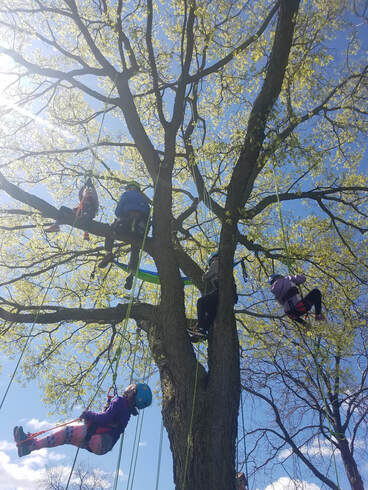 Technical Tree Climbing When we moved to St. Louis, we had a sugar maple that could be climbed, but it wasn’t nearly as much fun as my previous climbing tree. Aside from the maple, we had oaks, hickories, and elms that were too tall to climb since the lowest branches were about 20’ high. If you have the desire to climb into taller, larger, older trees, you are out of luck if they do not have low and small enough branches for climbing. Thankfully, ropes, saddles and specialized techniques allow us to climb into these magnificent trees. Climbing rope requires a unique set of motor skills and spatial awareness in addition to those skills we developed as free-climbers. It also requires the use of muscles you may not have known were there! Sitting back in your saddle and letting the tree and rope support your weight has an energizing effect. Once you climb into the crown of the tree and can play in the branches, you are continuously transferring your weight and sense of security between sitting in rope and being supported by a branch. The transition back and forth brings new challenges. This is part of what makes technical tree climbing a lot of fun and different from free-climbing. Once you begin to master the balance between using branches and using rope, you are better able to climb and explore the tree at will. You are able to enjoy the freedom of spending time in the branches without having to hold on. Another key difference is that, with rope, you can climb much higher. Some of the taller trees in Wisconsin allow us to ascend over 100 feet above the ground. The tallest trees in the world allow climbers to reach heights over 350 feet. While these heights sound impressive, the reality is that most people are challenged and impacted by reaching heights between 10 and 35 feet. The trees we climb around Wisconsin are perfect as they allow us to play in this realm. For those who like pushing the limits, I often include a few ropes that reach 40-50 feet during my climbs. In private excursions and guided climbs, we go even higher. In the end, the height each of us is most comfortable at will vary greatly. Using rope and saddle enables you to progressively challenge yourself to reaching new heights. Climb Trees
As a kid, I free-climbed trees because I didn’t know any other way. These days I climb using rope and saddle. Thanks to this hobby, I am able to explore amazing trees and chase views that few people will ever get to enjoy. I doubt my parents ever stopped to ponder the emotional and cognitive benefits I was receiving during my time in the trees. They knew it was important for kids to play outside because they could see the differences in my demeanor between those days and the ones I spent mostly inside in front of the tv and playing video games. Today, I notice differences in myself during and following my time in the trees. When I reflect back on my childhood, I am grateful my parents allowed me to climb trees. As long as you take into consideration that the tree you are climbing is a living being and do what you can to minimize your impact on the tree, I encourage you to get out and enjoy the trees. Take your children and loved ones with you. *Fine print: prior to entering a tree, I perform a thorough inspection to assess its health and structural integrity. There are a number of issues and conditions that can make a tree unfit for climbing. If you are unsure of the condition of your trees, please contact an ISA Certified Arborist and have them assess your tree (yes, even the small ones). If you are interested in climbing tall and mature trees, give me a call! I take a lot of pictures during our climbs. The experience is different for each climber, each person benefiting from it in their own way. Describing the different benefits that come from climbing trees can be difficult. But you can see it for yourself in this week’s video. Register for a climb today and come experience it for yourself! Warning: Playing outside can cause bruised arms, scraped knees, stubbed toes, dirty hands, stained clothing, muddy shoes. You will get wet when it rains, cold when temperatures are low, and hurt when you fall. Some people may require band-aids, ice packs, or loving arms to hold them as they cry. Life is one huge adventure for those who aren’t afraid of getting dirty. There are many places to explore, limitations to discover, and life lessons to learn. If we don’t learn them as children, then our road ahead will be hampered. Do you ever look back on your own childhood and feel grateful for the experiences you had and the lessons you learned when you were younger? You did not become the strong person you are today in spite of the challenges you faced, but rather because of them. I found it humorous, if not annoying, when my father would say, “when I was your age, I had to walk 5 miles to school.” My typical response was to roll my eyes, as that was what all old people said. These days I catch myself thinking and saying some of the same things! In reality, every generation thinks the next generation has it easier and aren’t as capable of dealing with hardships as they were. This has been going on for 2,000 years! (Check out this article: Proof That People Have Always Complained About Young Adults The more I consider the implications related this line of thinking, I think what we are really saying is that we are grateful for the challenges we had to face when we were younger and the leaders who provided encouragement and opportunities for me to do things for myself. This includes parents, teachers, and coaches. Facing Challenges I typically set up a number of ropes during a climbing event, each presenting different challenges for the climber. If your climbing rope is away from branches and hangs unimpeded from the top anchor point to the ground, your primary challenge will be dealing with your height above the ground and associated fears. By placing ropes so they hang near branches, you will face the challenge of maneuvering past the branch. The closer the rope is to the branch, the more difficult it is to climb around it. At one of our climbs this past summer, a young climber was climbing one of the more challenging rope routes of the day. The rope the young climber was on hung against a branch. With her weight on the rope, the rope rubbed snuggly against the branch above her head. Since her ultimate goal was to reach the top of the rope, well above this lower branch, she was going to have to get herself around it. Since the climbing knot slides up the rope that ran against the branch, she would need to pull the rope away from the branch in order to slide the knot around and above the branch. Until the knot was pulled away from the branch, there was a pinch point. In trying to get past the branch, she got her hand pinched between the rope and the branch. Ouch! She tried again. After a few attempts and just as many scratches on her fingers, she was beginning to get frustrated. After providing her with a few calming and encouraging words, she took a moment to analyze the challenge. Looking back up at the knot and impeding branch, she considered an alternative strategy that could potentially get her around the branch. Taking time to reassess the situation trying out an alternative technique was all she needed to figure out how she could overcome what seemed to be an insurmountable challenge. While her goal that day was to reach the top of that rope, the value of the climb happened along the way, and required a few scraped knuckles. She enjoyed her view of at the top, but she felt empowered and more self-confident because she was able to work past that lower branch. I am confident that the lesson she learned in the tree that day will stick with her as she faces challenges in school and work in her years ahead. Even more important, I hope she has the opportunity to encounter similar challenges often, for that is what will make her stronger and better prepared for what lays ahead. Learning On Our Own Often times adults are tempted to swoop in and offer up a solution as soon as we see a young person encountering an obstacle. With our life experience, I could picture the forthcoming pinch point for the young climber trying to get past the branch. In trying to help out, I could have interrupted her mental engagement and told her precisely how to avoid the obstacle. In doing so, I would have robbed her of the learning opportunity. However, we can only learn so much from listening or watching adults and leaders. We must do it on our own. Parents, teachers, and coaches are constantly balancing how much to help and how much to step back. Our role is to offer up and pass along knowledge to our children or students. It is up to them to take these tools and apply them to their own experiences. In order to teach a person how to climb up our ropes, our responsibility is to explain and demonstrate the knots and technique used to ascend. Then we need to step back and allow them to try on their own. They will make mistakes. They will move and process slower than us. This is the learning process which involves and extraordinary amount of activity going on inside the mind and body of the climber. The length of time required varies significantly between people and is greatly influenced by previous challenges they have faced and gained wisdom from. Should they make a mistake along the way, I have 2 basic options: correct them immediately or allow them to proceed. Ramifications of Rescuing If I jump in right away and correct them, then the lesson I am likely teaching them is that they can rely on me to help them through a struggle. They will eventually pick up the technique, but it usually takes much longer as they are not having to work through the steps on their own. Even if they want to figure it out by themselves, their mental process is derailed the moment I give them the answer. One issue with this approach is that I begin to anticipate when the climber is likely to face a struggle. Worse yet, I am then tempted to offer up the solution even before they are aware there is a challenge. Can you see how catastrophic this approach can be? We can deprive the climber of the opportunity to process and problem-solve because the solution is being provided to them before their mind even encounters the struggle. Freedom To Figure It Out
In contrast, if I allow them to proceed, they will soon figure out they missed a step. While it may look to bystanders that they are sitting there not knowing what to do, they are actually quite busy inside their head. They are processing through the information they gathered during my presentation and demonstration, then trying to figure out how to move their body in order to replicate the technique. They will figure it out. When they do, that is the moment they will have not only learned the process, but also became self-reliant, problem-solved, gained confidence, felt satisfaction, and built positive self-image. It is a challenge to determine the appropriate level of guidance to provide each climber. I strive to provide positive experiences as I do not like to see climbers become frustrated. The point of frustration triggers responses that are detrimental to a person’s learning process and obviously the enjoyment of the activity. Of course, there is a point at which we need to intervene in some manner. I just try to keep in mind that my ultimate goal is to help them learn how to do it on their own, not micromanage them to the top of the rope. It is fun to get to the top. It is rewarding if you do it on your own. Free play Bumps and bruises happen in all kinds of activities. They are part of the learning process. Not only should we not forget this, we should facilitate opportunities for girls and boys to face physical and mental challenges even if that exposes them to scrapes and scratches. With most anything we do, there are dangers involved that need to be addressed for safety. Once we’ve been able to set the parameters that help minimize the associated risks of severe injury, we should then encourage and allow children to have the opportunity to play freely. I am thankful for the knowledge my parents, teachers, and coaches provided me. I am even more grateful that they allowed me time for free play in order to practice, play, and work through the ways in which I could apply that knowledge. Bumps and bruises are often signs of growth and a lesson learned. Each scrape encountered plays an important role in developing creativity, self-confidence, problem-solving skills, and a positive self-image. Let’s not deprive kids these days of these important opportunities to grow!  Curt and Dr. Gathright Curt and Dr. Gathright Dr. John Gathright was an author and motivational speaker, not a tree climbing expert. He wrote a book about pursuing your dreams, and at one of his book signing events, he was approached by a woman. Speaking from her wheel chair, Toshiko Hikosaka told him of her dream to climb the world’s largest tree and that she wanted him to help her. He was not a tree climber and had no idea how to climb such a tree, but he wanted to help her achieve her dream. Three years later, Gathright and Hikosaka reached the top of a giant sequoia. At 63 years old, she was the first paraplegic to climb a tree to this height. Her climb that day culminated in triumph, wonder and exhaustion. They spent the night in the top of that 243-foot tall tree, on the branches, under the stars. Just as that day in the bookstore had set the ball rolling for their 3-year journey, the climb to the top of the sequoia was the beginning of the next chapter. Upon returning to Japan, demand for Gathright’s tree climbing adventures inspired him to cut his own path forward. Given there were no tree climbing schools in the country at that time, he had to start at the very beginning. It was a delight for me to be able to attend a presentation of Dr. Gathright recently. He is a pioneer in using recreational tree climbing in therapeutic and rehabilitation programs, and I have been inspired by his work for a number of years. To hear him tell his story of the legwork he had to go through was amazing. Sometimes It Is About The Numbers He had to find research that supported his idea of establishing tree climbing as an effective and legitimate form of therapy. No research existed at that time, therefore he realized his next course of action was going to have to be the pursuit of his PhD studying and testing his hypothesis. His doctoral thesis looked at the physiological and physical differences in individuals between their climbing living trees and climbing a concrete structure. In both instances, participants were climbing to elevated heights and performing similar tasks. In analyzing the data, there were clear differences between the 2 experiences. When climbing trees, participants experienced less pain and fatigue, experienced greater vitality and clarity of mind, and reported feeling a greater feeling of self-worth versus when they were climbing the concrete structure. Tree climbing had produced an increase in positive emotions and reduction in negative emotions. His further studies revealed and measured reductions in participant levels of stress, tension, anxiety, depression, and anger after climbing trees. Not only did his research show the positive effects of tree climbing, it revealed that it wasn’t simply the climbing that was providing the benefit. There was a marked enhancement of the effects when the participants were climbing trees. Gathright had provided the scientific basis behind his TreeHab and Tree Therapy programs. Meet Your Therapist My first ascent of a tall tree early in my career had a profound impact on me physically and mentally. My muscles enjoyed the physical exertion, but I was exhausted. I was energized by the height I had reached, at the same time nervous. Through all of the hormones flushing through my body, I found mental clarity and focus. I was energized, yet I was at peace. I never measured the effects to confirm in what ways and by how much climbing trees changed me, yet I walked away from that climb relaxed and inspired. And every climb since. Over 20 years later, I came across the research of Dr. John Gathright that identified and quantified the effects of climbing trees that I had personally experienced. From its origins in 2000, TreeHab has worked with thousands of children with physical disabilities and emotional trauma. Gathright and Tree Climbing Japan have helped over 300,000 people of all abilities discover their inner tree-climber. As I listened to him share his stories of people he has worked with over the years, I was reminded of those who have touched me during my journey thus far. Tree Climbing Touches Lives I am involved with tree a climbing program for urban youth and people who do not have the resources to leave the concrete and asphalt landscape at will. Counselors and therapists utilize our climbing experience in their dealings with children facing emotional trauma, such as that related to the loss of a parent. It was interesting to hear him speak of programs developed for people with autism and ADHD. While the experience and benefits of tree climbing have a profound impact on these participants, it appears that TreeHab is also having a promising impact on breaking down the stigmas associated with them in his community. I have seen the benefits first hand in dealing with a variety of people from all walks of life and backgrounds. While the majority of our climbers may not fall into any of these categories, every one of us benefits from the same effects that tree climbing provides. His words brought into focus for me that we each have our own inhibitions, insecurities, and unique qualities. Each of us may be at a different point in our journey through life, come from different backgrounds and face our own challenges; but, every one of us can reap the benefits of time in the trees. Through this past year, the vast majority of climbers returned to the ground with a sense of accomplishment, feeling of pride, boost in self-confidence, and a big smile on their face. We met parents who were supportive of their children, speaking with words of love and encouragement. There were participants who overcame their trepidation and ended up excelling and enjoying their time above the ground. A number of children and young adults had the exciting opportunity to participate in an activity alongside their parents and grandparents. With so many fantastic memories and wonderful people, I was tempted to put together a year-end video recap of the year. We were able to capture many nice images of climbers, but there are too many for us to make a video with a realistic time length. In this period of reflection, I am inspired to share your pictures in a series of videos related to our experiences with trees and tree climbing. Inspired by Robert Fulgham's book All I Really Need to Know I Learned in Kindergarten... and our interactions together, I created this video to share a few of the lessons trees have taught me throughout my journey thus far. Your day in the trees may have been captured in this video. If not, I hope you will keep an eye out in the coming months as I cycle through as many of the images as I can in upcoming videos. Other images will grace our website pages and posts on Facebook and Instagram. 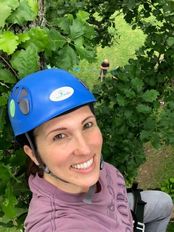 By Sarah Schwab My kids had several different reactions when I told them we were going to go tree climbing. “That’s cool” they said at first. It’s something different and even exciting. Then, when we were on our way to the climb, my older son’s nerves started to kick in. “How high do we climb in the tree?” he asked. I told him it’s possible to get up pretty high, but assured him he wouldn’t have to go any higher than he was comfortable and could stop at any time. Meanwhile, the youngest one was tired, hungry and a little cranky and decided he no longer wanted to go. “I changed my mind” he said. My daughter was quiet the entire time, just going along obediently. “Oh boy,” I thought to myself, “this is going to be interesting.” When we arrived and the kids started getting harnessed up, their demeanor changed. They learned the technique for climbing up the rope, and as their feet lifted off the ground, smiles spread across their faces. “Hey mom! Look at me!” At this point, parents seem to make one of three choices… Stay And Watch Many parents stand on the sidelines, watching their kids ascend the rope and get up into the tree. They snap some pictures, enjoying the view from a distance. As parents, we are used to sitting and watching as our kids play sports, perform in concerts, take lessons, play laser tag at a birthday party, or whatever. So it is understandable that many parents stand outside the roped-off perimeter, keeping their feet on the ground. Go Away In some cases, when kids are registered to be climbing trees for a couple of hours, parents will drop them off at the beginning and pick them back up again at the end, taking the opportunity to have some time on their own. The kids are in good hands with the staff, and adults can get a little time to run errands or do something for themselves. At the climb we did at Fox Brook Park, one mom ran around the lake getting her own exercise and checking in each time she passed by. Join In Tree climbing is one of the rare opportunities for parents to join in with their kids. That’s what I did! Once the kids were off the ground, I saddled up and started to climb as well. It’s really special to share an experience like that together. When the kids said “Hey mom, look at this!” they knew I could really appreciate what they were showing me. We were able to laugh with each other, meet up in the branches of the tree, and try fun tricks together. I still got some great pictures, only from up in the tree rather than down on the ground. Of course, I’m also the mom who suited up and played laser tag at the birthday party! I think parents should be able to try new things and have some fun as well, even if we feel a little scared or uncomfortable. If we want our kids to challenge themselves, then modeling that behavior is important. After all, kids are more likely to do what we do and not what we say. Watch Your Words Speaking of the things parents say, the rule of thumb is to say as little as possible. No matter which choice you make as a parent, one of the hardest but most important things is to keep your mouth shut. Parents usually want to be encouraging, and it is tempting to yell things to the kids – “Climb higher! Keep going! Lift up your knees.” It is done with good intensions, but can actually end up negatively impacting everyone’s experience. The kids are learning something new. Maybe they are focusing on the technique, maybe they are overcoming a fear of heights, maybe they just want to stop and enjoy the feeling and the view. When you aren’t up in the tree, you can’t relate to their experience. Even encouragement can cause distraction, both for your kids, the other climbers, and the staff. An important piece of the tree-climbing experience is leaving the kids alone to do it themselves. Each kid learns in a different way, climbs at a different pace, and enjoys different aspects of the experience. It’s not a race, and there is no winning or losing. My kids all had a blast, climbed different ropes, reached different heights. And in the end, we all had a shared memory we could talk about together. That seems like a win to me! |
AuthorAs a G.O.T.C. Recognized Master Instructor & Facilitator, I.S.A. Board Certified Master Arborist, and T.C.I.A. Certified Treecare Safety Professional, Curt has spent over 30 years dedicated to the study and care of trees. Categories
All
Archives
May 2024
|
|

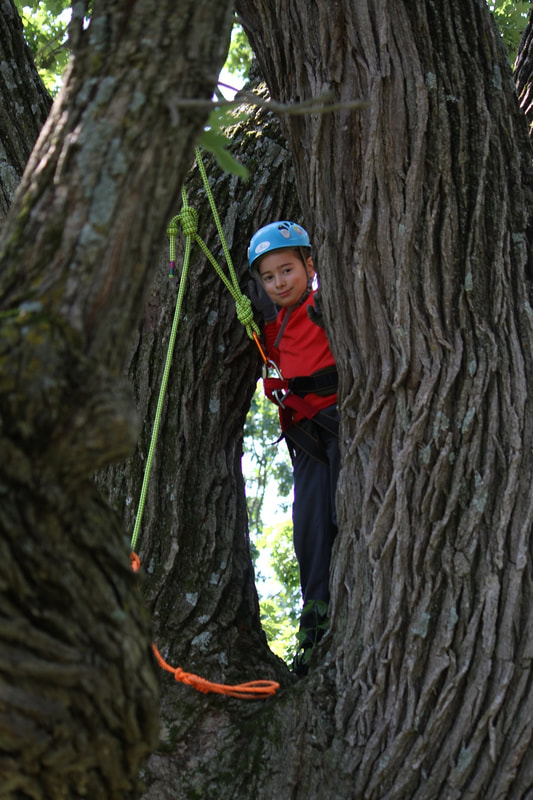
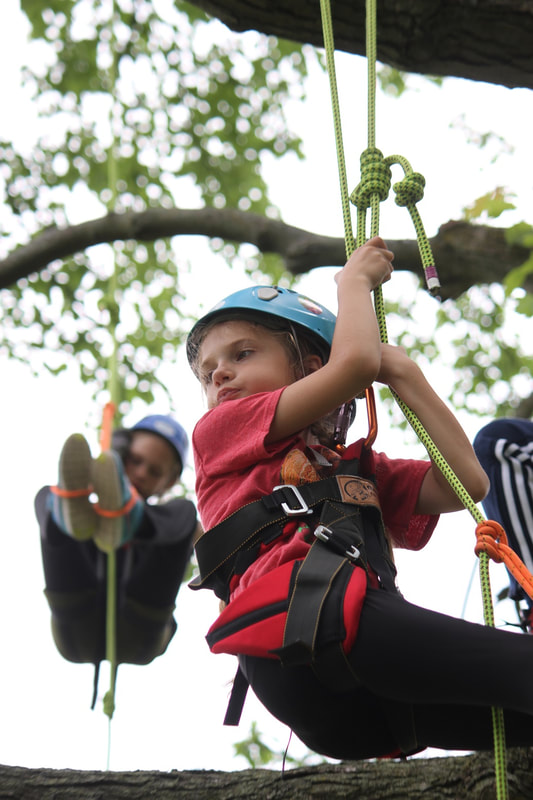
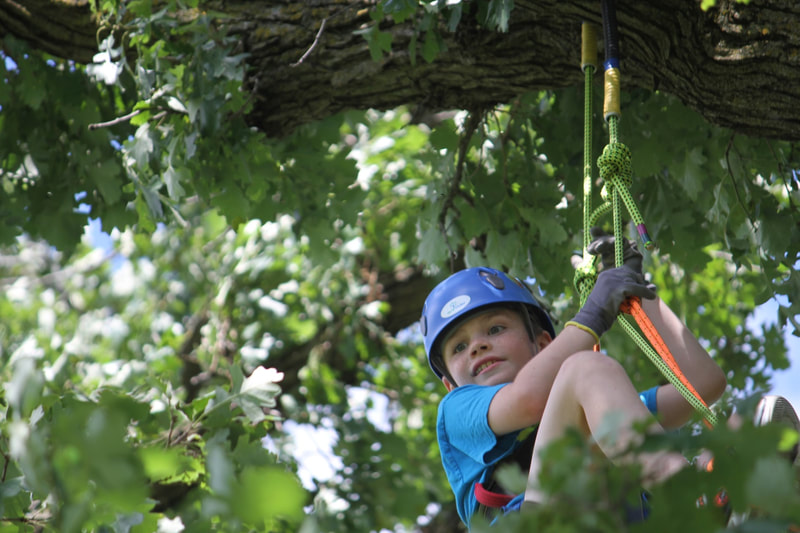
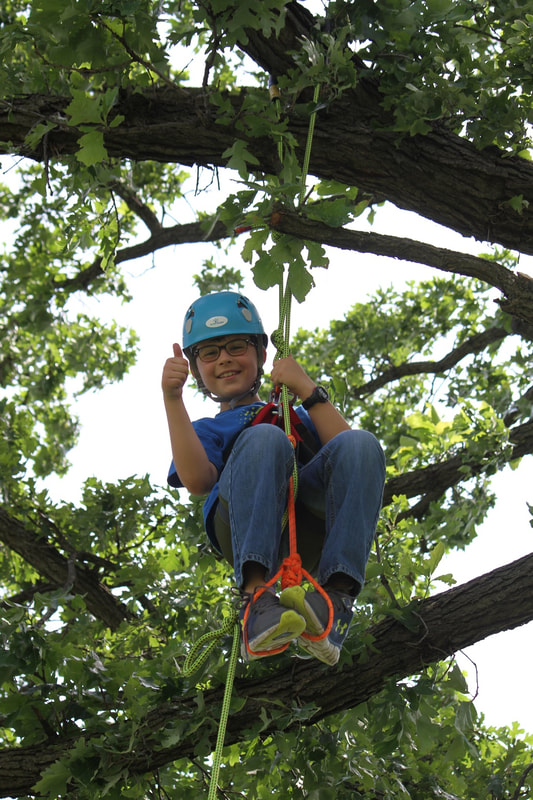
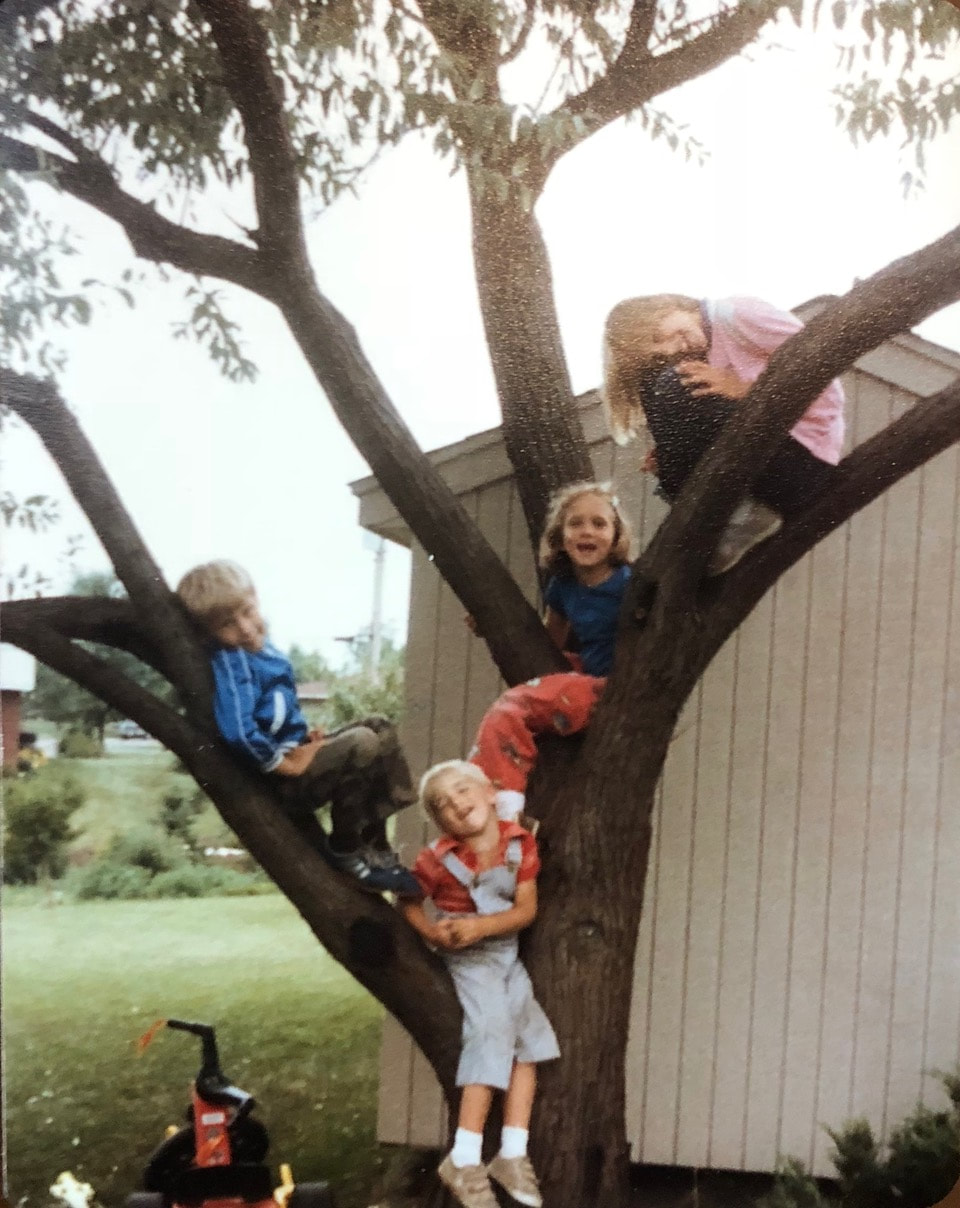
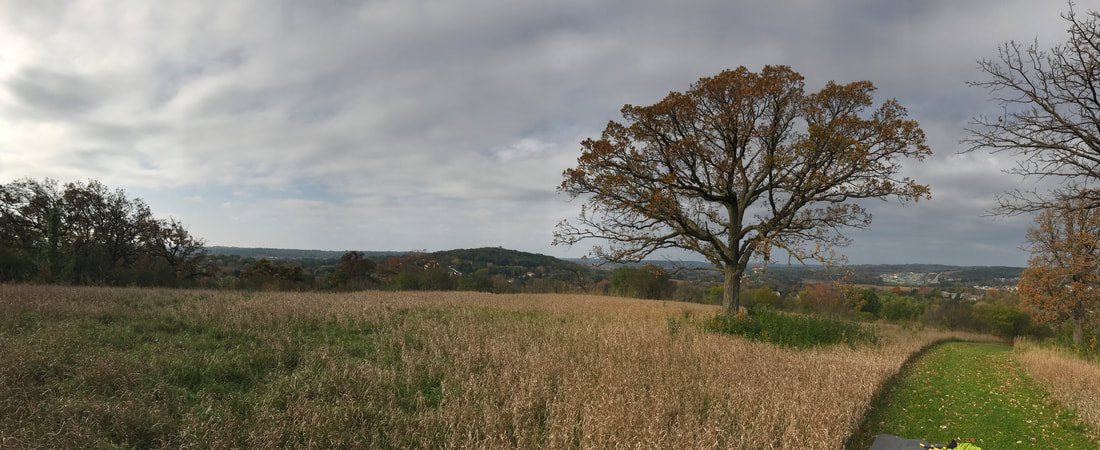
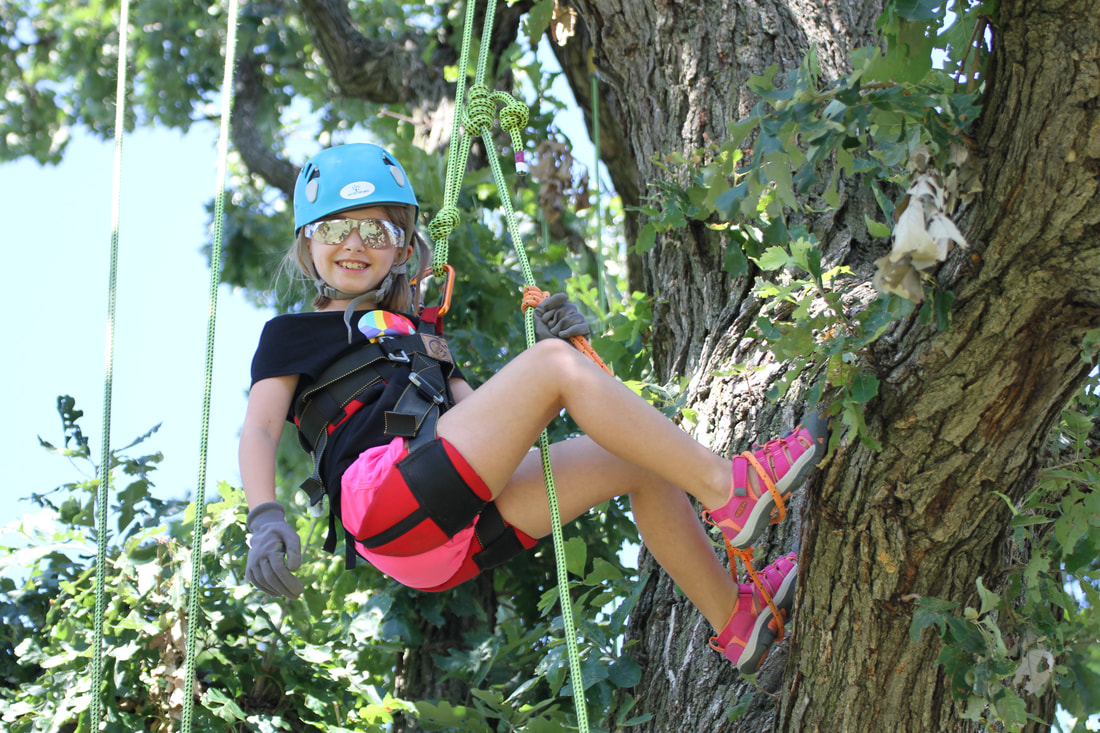
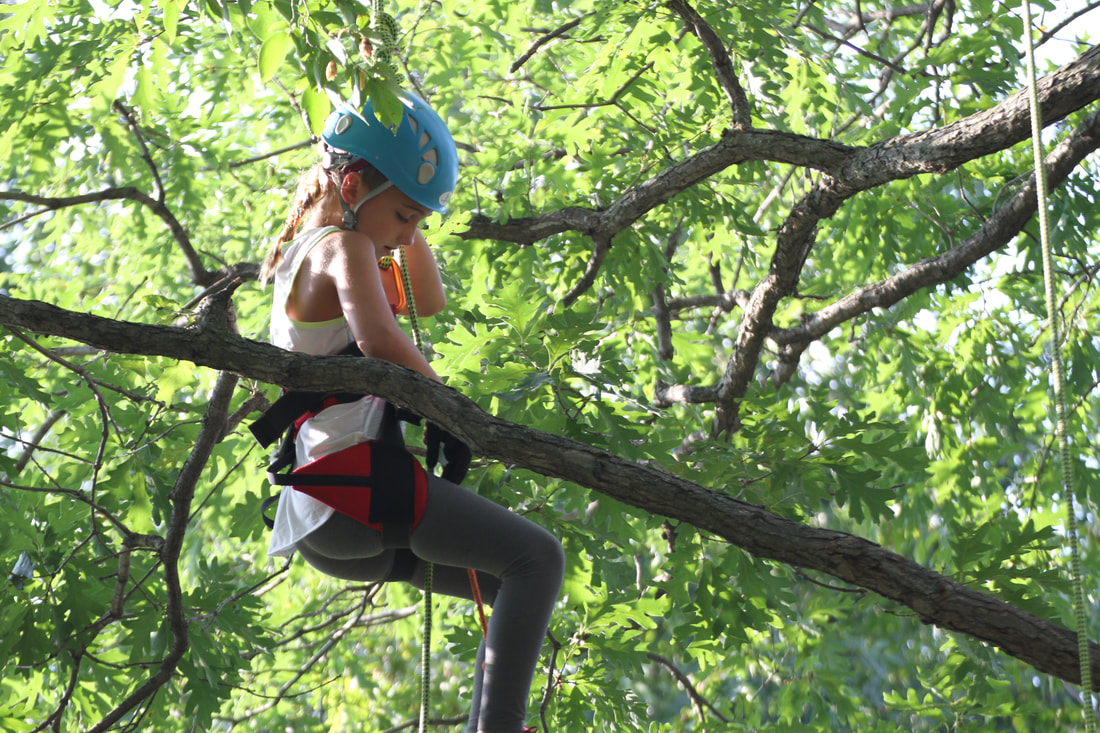
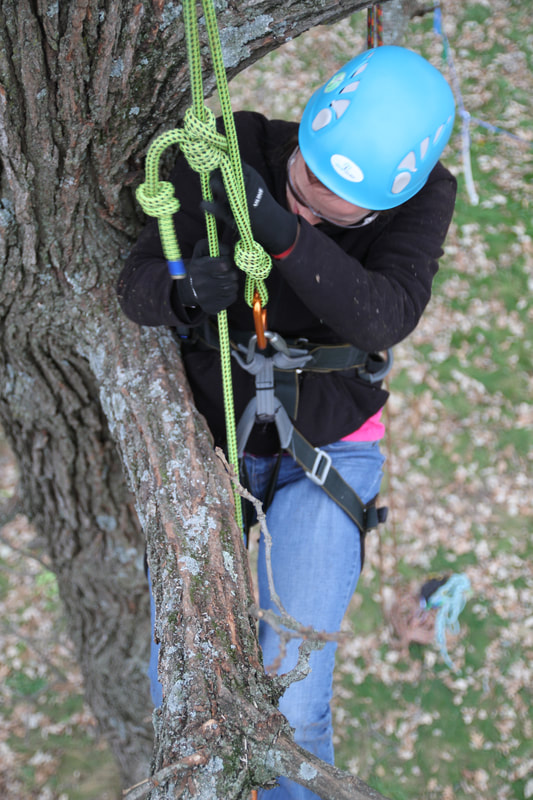
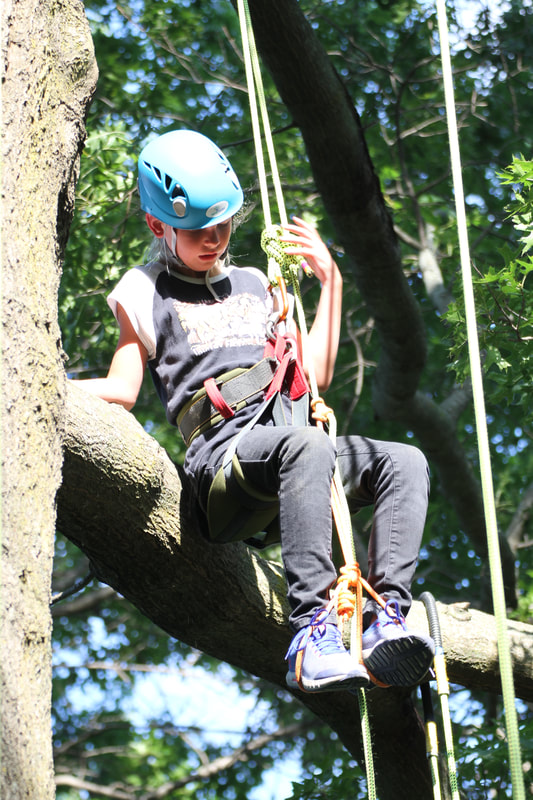
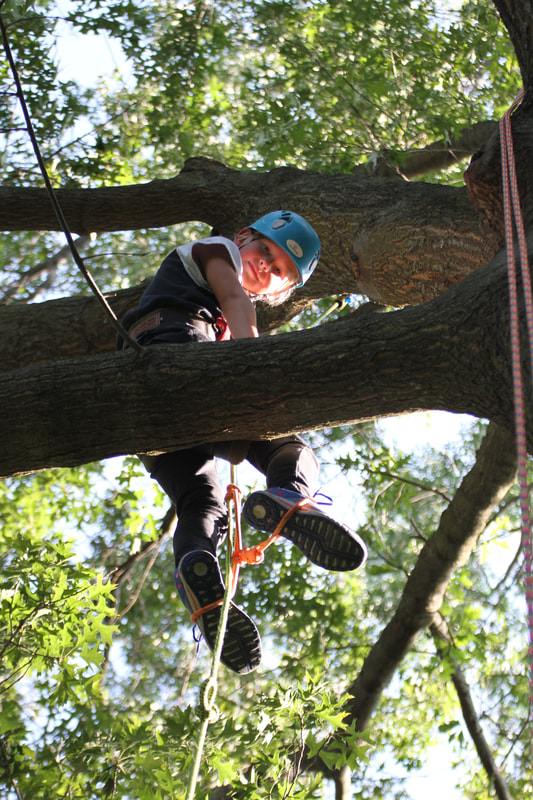
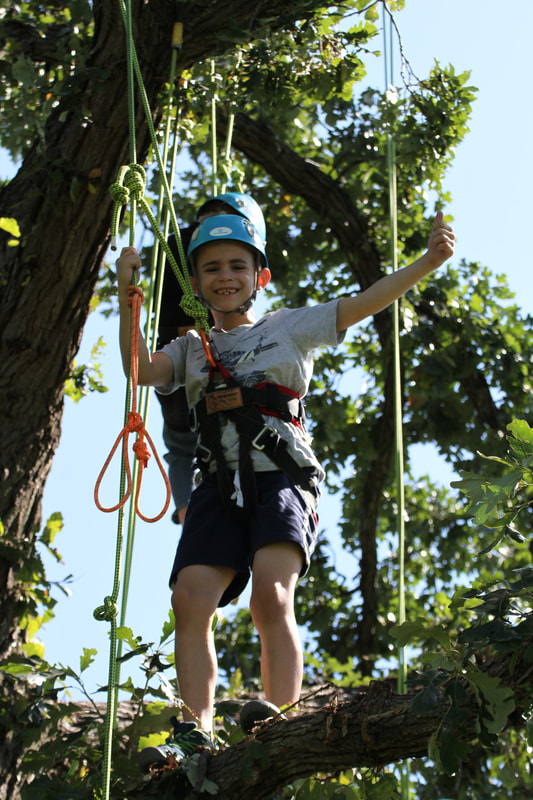
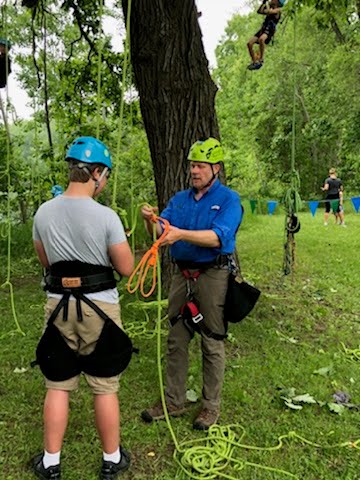
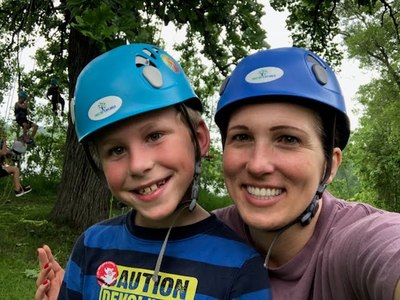
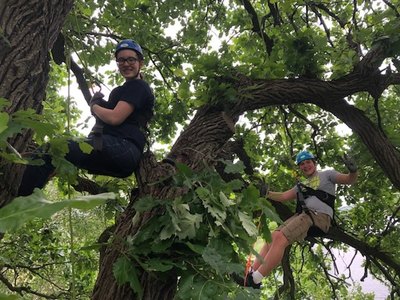
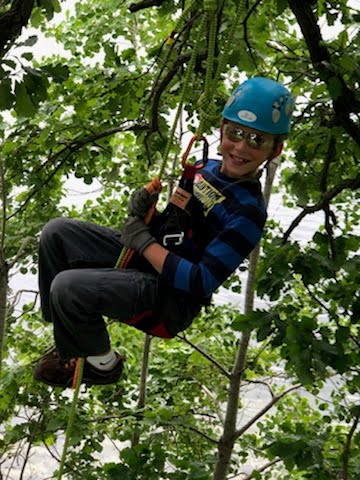
 RSS Feed
RSS Feed
